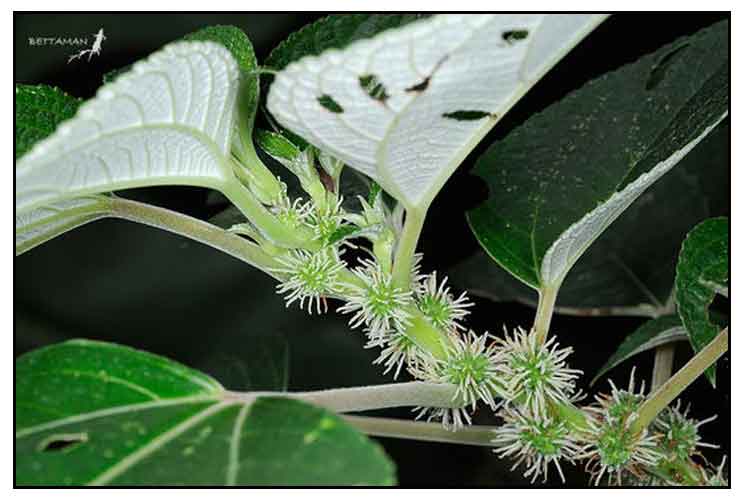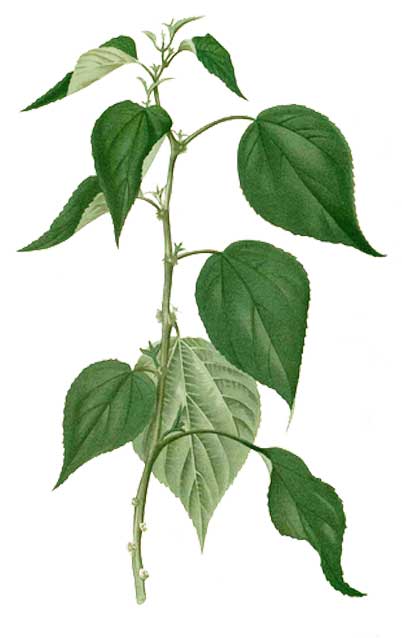 Botany Botany
Dalunot is a dioecious shrub or small tree attaining a height of 3 to 5 meters. Leaves are ovate, 7 to 8 centimeters long, 3 to 10 centimeters wide, with the tip tapering to a point and the base rounded or somewhat heart-shaped, the margins toothed, the upper surface green, slightly hairy and a little rough, the lower surface pale and rather densely covered with soft hairs. Male flowers are borne in dense, axillary fascicles, with greenish-white and exerted styles. Female flowers are small and greenish, in dense, axillary, hemispheric heads, 5 to 6 millimeters in diameter, with long-exerted styles. Fruit is white, very soft and fleshy, depressed, nearly spherical, about 1 centimeter in diameter, and consists of many small achenes immersed in the fleshy perianths.
 Distribution Distribution
- Very common and widely distributed species.
-
In thickets and secondary forests at low and medium altitudes from the Batan Island to Mindanao and Palawan.
-
In Benguet, Luzon it ascends to an altitude of 2,000 meters.
- Also occurs in Borneo and Botel Tobago.
Constituents
- Phytochemical screening of crude methanol extracts yielded anthrones, flavonoids, glycosidic flavonoids, phenolic compounds, steroids, tannins, triterpenes, anthraquinones, and coumarins, with an absence of alkaloids. (see study below) (1)
- Dichlormethane extracts yielded ursolic acid (1), oleanolic acid (2), friedelin (3), ß-sitosterol (4), and stigmasterol (5) from the twigs. Leaves yielded 4,5, squalene (6), chlorophyll a (7), and polyphenol (8). (4)
- Methanol extract of air-dried leaves yielded a long-chain alkene (1-hexacosene) and a terpene. (see study below) (5)
- Fractionation of a hexane extract of leaves yielded three pure compounds, two were were triterpenes, and the third, a sterol. (see study below) (6)
- Study of dichlormethane extract of P. arborescens yielded triterpenes, squalene (1), friedelin (2), and a mixture of ursolic acid (3a) and oleanic acid (3b) in a 2:3 ratio, and a mixture of sitosterol (4a) and stigmasterol (4b) in a 2:1 ratio. (see study below) (9)
- Study of a hexane extract of Pipturus arborescens leaves isolated three pure compounds characterized as triterpenes from mass spectral and NMR data. The triterpenes were identified as glutinon, friedelin and glutinol. A mixture of common plant sterols of campesterol, stigmasterol, and sitosterol were identified by GC-MS. (see study below) ) (10)
Properties
- Studies have suggested radical scavenging, antiproliferative, antimicrobial properties.
Parts used
Bark, leaves.
Uses
Edibility
- Fruits are edible.
Folkloric
- In the Philippines bark scraping used externally as a cataplasm for boils.
- Leaves used for treating herpes simplex and skin diseases.
(1)
- Mansaka people of Mindanao apply scraped and pounded bark or pulp on wounds to enhance healing. (7)
Others
- Fibers: Bark fiber used in making rope. (8)
Studies
• Radical Scavenging Activity / Cytotoxicity: In a study of four Philippine medicinal plants, Pipturus arborescens gave the second lowest LC50 and EC50 values for brine shrimp lethality assay and DPPH radical scavenging activity. Extracts of the plant also showed to be active against HeLa cells. Extract also showed 100% mortality in the Brine Shrimp lethality assay. (1)
• Cytotoxic Alkene and Terpene / Leaves: Study isolated a long-chain alkene (1-hexacosene) and a terpene from a methanol extract of air dried leaves. The isolated compounds showed moderate cytotoxicity against brine shrimp Artemia salina. (5)
• Antimicrobial / Leaves: Study evaluated the antimicrobial potential of methanolic crude extract of leaves of Pipturus arborescens. Fractionation of a hexane extract isolated three pure compounds, two were triterpenes, and the third, a sterol. Triterpene PA was found active against Pseudomonas aeruginosa at 50 µg/ml. (6)
• Antiproliferative Against Human Cancer Cell Lines / Triterpenes: Study triterpenes isolated from dichlormethane extract for antiproliferative activities against three human cancer cell lines viz., breast (MCF-7), colon (HT-29 and HCT-116). The HCT-116 cell line was most susceptible to the compounds and mixtures tested. Triterpene 1 was most cytotoxic against HCT-116 and MCF-7 with IC50s of 4.21 and 5.92 µg/mL, respectively. Other triterpenes and mixtures showed varying degrees of cytotoxicity against the cancer cell lines. (see constituents above) (9)
• Anti-Pseudomanal Potential / Triterpenes / Glutinone / Leaves: Study of a hexane extract of Pipturus arborescens leaves isolated three pure compounds characterized as triterpenes from mass spectral and NMR data. The triterpenes were identified as glutinon, friedelin and glutinol. A mixture of common plant sterols of campesterol, stigmasterol, and sitosterol were identified by GC-MS. Glutinone at 50 µg/ml showed significant activity against Pseudomonas aeruginosa, a multidrug resistant microorganism. Infections caused by the organism are often malignant and resistant to treatment It also showed weaker activity against Staphylococcus aureus and Escherichia coli. (10)
• Cytotoxicity / Antibacterial / Leaves: Study evaluated extracts of P. arborescens for cytotoxicity and antibacterial activities. Three extracts showed low to moderate cytotoxicity in Brine Shrimp Lethality shrimp Assay. Both chloroform and ethanolic extracts were active against Bacillus subtilis and Staphylococcus aureus. The ethyl acetate extract was active against B. subtilis only. (11)
Availability
Wild-crafted.
|

![]()



 Botany
Botany Distribution
Distribution